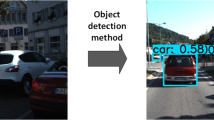Abstract
Automated driving is an inevitable trend in future transportation, it is also one of the eminent achievements in the matter of artificial intelligence. Deep learning produces a significant contribution to the progression of automatic driving. In this paper, our goal is to primarily deal with the issue of vehicle-related scene understanding using deep learning. To the best of our knowledge, this is the first time that we utilize our traffic environment as an object for scene understanding based on deep learning. Moreover, automatic scene segmentation and object detection are joined for traffic scene understanding. The techniques based on deep learning dramatically decrease human manipulations. Furthermore, the datasets in this paper consist of a large amount of our collected traffic images. Meanwhile, the performance of our algorithms is verified by the experiential results.
Access this chapter
Tax calculation will be finalised at checkout
Purchases are for personal use only
Similar content being viewed by others
References
Li, Y., Dong, G., Yang, J., Zhang, L., Gao, S.: 3D point cloud scene data acquisition and its key technologies for scene understanding. Laser Optoelectron. Progr. 56(4), 040002 (2019)
Chen, H., et al.: The rise of deep learning in drug discovery. Drug Discov. Today 23(6), 1241–1250 (2019)
Husain, F., Dellen, B., Torras, C.: Scene understanding using deep learning, pp. 373–382. Academic Press (2017)
Yang, S., Wang, W., Liu, C., Deng, W.: Scene understanding in deep learning-based end-to-end controllers for autonomous vehicles. IEEE Trans. Syst. Man Cybern.: Syst. 49(1), 53–63 (2019)
Jin, Y., Li, J., Ma, D., Guo, X., Yu, H.: A semi-automatic annotation technology for traffic scene image labelling based on deep learning pre-processing. In: IEEE International Conference on Computational Science and Engineering (CSE) and IEEE International Conference on Embedded and Ubiquitous Computing (EUC), pp. 315–320 (2017)
Nikita, D., Konstantin, S., Julien, M., Cordelia, S.: BlitzNet: A real-time deep network for scene understanding. In: IEEE International Conference on Computer Vision (ICCV), pp. 4154–4162 (2017)
Yao, W., Zeng, Q., Lin, Y., Guillemard, F., Geronimi, S., Aioun, F.: On-road vehicle trajectory collection and scene-based lane change analysis. IEEE Trans. Intell. Transp. Syst. 18(1), 206–220 (2017)
Wei, Y., Tian, Q., Guo, J., Huang, W., Cao, J.: Multi-vehicle detection algorithm through combining Harr and HOG features. Math. Comput. Simul. 155, 130–145 (2017)
Lecun, Y., Muller, U., Ben, J., Cosatto, E., Flepp, B.: Off-road obstacle avoidance through end-to-end learning. In: International Conference on Neural Information Processing Systems, pp. 739–746 (2005)
Ohsugi, H., Tabuchi, H., Enno, H., Ishitobi, N.: Accuracy of deep learning, a machine-learning technology using ultra-wide-field fundus ophthalmoscopy for detecting hematogenous retinal detachment. Sci. Rep. 7(1), 9425 (2017)
Li, F., Deng, J., Li, K.: ImageNet: constructing a largescale image database. J. Vis. 9(8), 1037–1038 (2009)
Samui, P., Roy, S.S., Balas, V.E.: Handbook of Neural Computation, pp. 12–34. Academic Press, Cambridge (2017)
Yu, Y., Cao, K.: A method for semantic representation of dynamic events in traffic scenes. Inf. Control 44(1), 83–90 (2015)
Newton, A., Pasupathy, R., Yousefian, F.: Recent trends in stochastics gradient descent for machine learning and big data. In: Winter Simulation Conference (WSC), pp. 366–380 (2018)
Goodfellow, I., Bengio, Y., Courville, A.: Deep Learning, pp. 44–56. The MIT Press, Cambridge (2016)
Tran, S., Kwon, O., Kwon, K., Lee, S., Kang, K.: Blood cell images segmentation using deep learning semantic segmentation. In: IEEE International Conference on Electronics and Communication Engineering (ICECE), pp. 13–16 (2018)
Badrinarayanan, V., Handa, A., Cipolla, R.: SegNet: a deep convolutional encoder-decoder architecture for robust semantic pixel-wise labelling. IEEE Trans. Pattern Anal. Mach. Intell. 39(12), 2481–2495 (2017)
Ren, S., He, K., Girshick, R., Sun, J.: Faster R-CNN: towards real-time object detection with region proposal networks. Pattern Anal. Mach. Intell 39(6), 1137–1149 (2017)
Ji, H., Liu, Z., Yan, W., Klette, R.: Early diagnosis of Alzheimer’s disease based on selective kernel network with spatial attention. In: ACPR (2019)
Al-Sarayreh, M., Reis, M.M., Yan, W.Q., Klette, R.: A sequential CNN approach for foreign object detection in hyperspectral ımages. In: Vento, M., Percannella, G. (eds.) CAIP 2019. LNCS, vol. 11678, pp. 271–283. Springer, Cham (2019). https://doi.org/10.1007/978-3-030-29888-3_22
Ji, H., Liu, Z., Yan, W., Klette, R.: Early diagnosis of Alzheimer’s disease using deep learning. In: ICCCV 2019, pp. 87–91 (2019)
Shen, Y., Yan, W.: Blindspot monitoring using deep learning. In: IVCNZ (2018)
Pan, C., Li, X., Yan, W.: A learning-based positive feedback approach in salient object detection. In: IVCNZ (2018)
Wang, X., Yan, W.Q.: Cross-view gait recognition through ensemble learning. Neural Comput. Appl. (2019). https://doi.org/10.1007/s00521-019-04256-z
Liu, X.: Vehicle-related Scene Understanding. Masters thesis, Auckland University of Technology, New Zealand (2019)
Wang, X., Yan, W.: Human gait recognition based on frame-by-frame gait energy images and convolutional long short-term memory. Int. J. Neural Syst. 30(1), 1950027:1–1950027:12 (2020)
Wang, X., Zhang, J., Yan, W.Q.: Gait recognition using multichannel convolution neural networks. Neural Comput. Appl. (2019). https://doi.org/10.1007/s00521-019-04524-y
Author information
Authors and Affiliations
Corresponding author
Editor information
Editors and Affiliations
Rights and permissions
Copyright information
© 2020 Springer Nature Singapore Pte Ltd.
About this paper
Cite this paper
Liu, X., Neuyen, M., Yan, W.Q. (2020). Vehicle-Related Scene Understanding Using Deep Learning. In: Cree, M., Huang, F., Yuan, J., Yan, W. (eds) Pattern Recognition. ACPR 2019. Communications in Computer and Information Science, vol 1180. Springer, Singapore. https://doi.org/10.1007/978-981-15-3651-9_7
Download citation
DOI: https://doi.org/10.1007/978-981-15-3651-9_7
Published:
Publisher Name: Springer, Singapore
Print ISBN: 978-981-15-3650-2
Online ISBN: 978-981-15-3651-9
eBook Packages: Computer ScienceComputer Science (R0)




